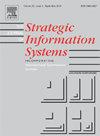从社会认知角度看数字创新网络中的知识整合
IF 11.8
2区 管理学
Q1 COMPUTER SCIENCE, INFORMATION SYSTEMS
引用次数: 0
摘要
数字创新是一个复杂的过程,在这一过程中,参与者通过在分层模块架构中组合数字资源来创造新的价值途径。虽然信息和通信技术学术界对在组织内部环境中开发和实施数字化人工制品有着丰富的研究传统,但我们对分布式创新网络中知识整合的理解却刚刚起步,理论化程度不足。鉴于数字创新网络的重要性日益凸显,以及整合专业知识所面临的挑战,尤其是数字技术带来的更大多样性、速度、影响力和范围,这是一个重要的研究领域。通过对一个涉及多个组织和学科的健康物联网项目的深入案例研究,我们探讨了在数字创新网络的启动阶段,知识是如何跨界整合的。我们的研究结果指出了与数字平台的组织愿景、资源分配、交付路线图、技术架构和知识产权相关的界限,仅举几例。然后,我们揭示了知识整合的五种社会认知模式,参与者通过这些模式战略性地跨越句法、语义和实用边界:这些模式是:发出信号(Signalling)、组合(Assembling)、争论(Contesting)、折扣(Discounting)和最终确定(Finalising)。模式的选择取决于网络行动者的感知知识地位("他们知道什么")和社会地位("他们是谁"),这凸显了知识整合的社会和认知依赖性的显著性。我们进一步讨论了设计对象在克服数字创新网络中专业参与者之间的差异和区别方面的贡献。本文章由计算机程序翻译,如有差异,请以英文原文为准。
A socio-cognitive perspective of knowledge integration in digital innovation networks
Digital innovation is a complex process in which actors seek to create new value pathways by combining digital resources in a layered modular architecture. While IS scholarship has a rich tradition of research on developing and implementing digital artefacts within intra-organisational contexts, our understanding of knowledge integration across distributed innovation networks is nascent and under-theorised. This is an important area of research given the rising importance of digital innovation networks and the challenges faced in integrating specialised knowledge, especially given the greater diversity, speed, reach, and scope made possible by digital technologies. Drawing on in-depth case study findings from a health IoT project involving multiple organisations and disciplines, we explore how knowledge is integrated across boundaries during the initiation stage of a digital innovation network. Our findings point to boundaries related to the digital platform’s organising vision, resource allocation, delivery roadmap, technical architecture, and intellectual property, to name but a few challenges. We then reveal five socio-cognitive modes of knowledge integration which actors strategically enact to cross syntactic, semantic, and pragmatic boundaries: Signalling, Assembling, Contesting, Discounting, and Finalising. The choice of mode depends on the perceived knowledge status (‘what they know’) and social status (‘who they are’) of network actors, which highlight the salience of both social and cognitive dependencies for knowledge integration. We further discuss the contribution of design objects for overcoming differences and distinctions between specialist actors in a digital innovation network.
求助全文
通过发布文献求助,成功后即可免费获取论文全文。
去求助
来源期刊

Journal of Strategic Information Systems
工程技术-计算机:信息系统
CiteScore
17.40
自引率
4.30%
发文量
19
审稿时长
>12 weeks
期刊介绍:
The Journal of Strategic Information Systems focuses on the strategic management, business and organizational issues associated with the introduction and utilization of information systems, and considers these issues in a global context. The emphasis is on the incorporation of IT into organizations'' strategic thinking, strategy alignment, organizational arrangements and management of change issues.
 求助内容:
求助内容: 应助结果提醒方式:
应助结果提醒方式:


